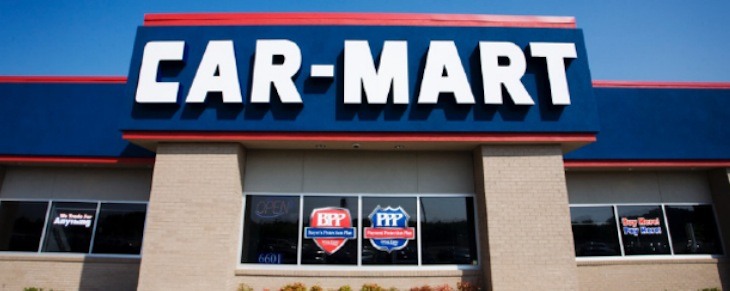Car-Mart profit to rise 48% in fourth quarter, up 27% for the year
by May 2, 2018 2:05 pm 464 views

America’s Car-Mart earnings are expected to rise 48.5% to 98 cents per share in the fourth quarter and 27.7% to $3.18 cents per share for the year, based on a consensus of analysts. Revenue is projected to rise 3.8% to $158.73 million for the quarter and increase 2.2% to $600.88 million for the year.
The Bentonville-based buy here, pay here used car dealer plans to report fourth-quarter and full-year financial results, for the period ending April 30, after the markets close May 21. Shares of Car-Mart (NASDAQ: CRMT) closed at $53.60, up 30 cents or 0.56%, on Tuesday (May 1). In the past 52 weeks, the stock has ranged between $54.25 and $33.05.
In a first-quarter earnings preview, equity analysts John Hecht and Kyle Joseph and associates Michael Del Grosso and Mark Drucker, all of Jefferies, expect Car-Mart will continue to manage inventory and expenses effectively and were hopeful to see continued year-over-year improvement in sales and credit. However, competition remained strong.
Across the auto finance industry, credit and used vehicle value trends looked to be more stable in the first quarter compared to the same period in the previous year, the analysts said. This might be offset by delayed tax refunds, as investors focus on rising rate impacts. The first quarter is often a period when credit improves and volume rises, but a delay in tax refunds, similar to 2017, could dampen this seasonal trend.
Through February, the number of federal tax refunds issued declined 1.8%, from the same period in 2017, according to J.D. Power Valuation Services. In March, the number of refunds issued declined 1.1%, from the same month in 2017. The average refund amount increased 0.5% to $2,893 in 2018, from 2017.
Federal tax returns have been a source of cash down payments for buyers of subcompact, compact and midsize cars, and prices in these segments increased 4.6%, 4.3% and 3.5%, respectively, according to J.D. Power. The three segments had the largest price growth in March, when wholesale prices of used vehicles up to eight years old increased 2.5%. As a result, the J.D. Power Valuation Services’ Seasonally Adjusted Used Vehicle Price Index rose 0.9 points to 115.9.
The number of delinquent accounts and net charge offs often fall as tax refunds are issued, and this triggers a purchasing cycle, leading sales volumes to rise, according to the Jefferies analysts. But like in 2017, taxpayers who claimed the earned income tax credit or additional child tax credit, didn’t start to see refunds until late February, which might have led to a longer period of credit issues. This had somewhat of an impact in trust data, and it might have led to higher delinquencies and net charge offs, also. When a vehicle is repossessed, the net charge off is the loss amount after the vehicle is sold on the wholesale market. For Car-Mart, losses as a percentage of gross finance receivables is expected to decline 100 basis points to 31%, from the same period in 2017.
In March, late-model auction volume rose 13.4% from February, but it declined 11.7% from March 2017, according to J.D. Power. Cars comprised of 52% of the auction volume, while trucks accounted for 48%. Through March, auction volume has fallen 5.3%, from the same period in 2017.
Used vehicle values will have an impact on recoveries, and in the first quarter, the usual upward pressure on used vehicle prices didn’t develop as a result of impacts from the hurricanes, which led prices to rise, and a delay in demand related to the timing of the tax returns.
In the first quarter, loan volumes are expected to rise while new car sales have fallen 3% annually and used car sales have declined 2%, according to Hecht, Joseph, Del Grosso and Drucker. However, banks have been tightening credit, and this might allow some companies to increase volume as sales across the auto industry fall. Except for loan terms, most lending factors have tightened. The worst of the competitive cycle looks to be in the past even as competition remains intense.
“Overall, we believe the ‘front book’ of auto loans is superior to the ‘back book’ that it is replacing, and that overall credit quality will improve over the passage of time,” according to the Jefferies analysts. In February, industry net charge offs declined 38 basis points to 2.88%, from the same month in 2017.
The analysts related to investors’ concerns on rising rates, as they impact sales volumes, the amount of financing that can be afforded and the net interest margin. However, auto loan lengths and asset-backed securities financing are expected to reduce this risk.
“Sentiment around the auto finance sector may continue to improve, allowing for increased multiples and equity values, which has traded below long-term averages for several years,” the analysts noted. “As important, while we believe we are at the beginning of the transition period — from intense competition to more rationalized competition — and while financial results may continue to reflect lower-than-average returns on capital, we may be seeing the light at the end of the tunnel as we begin to transition to a period of tightened underwriting and improving returns on capital, and equity values, over the course of (2018).”
